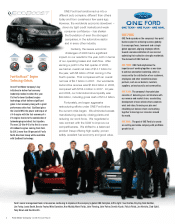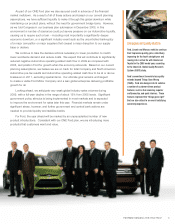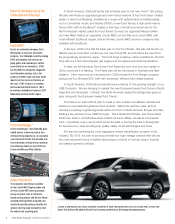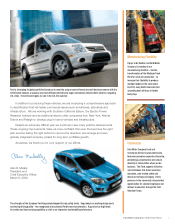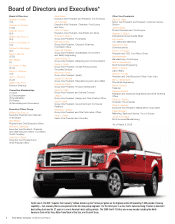Ford 2008 Annual Report Download - page 14
Download and view the complete annual report
Please find page 14 of the 2008 Ford annual report below. You can navigate through the pages in the report by either clicking on the pages listed below, or by using the keyword search tool below to find specific information within the annual report.
Management’s Discussion and Analysis of Financial Condition and Results of Operations
12 Ford Motor Company | 2008 Annual Report
Trends and Strategies
As indicated, we are in the midst of a global economic crisis that has included a sudden and substantial decline in
global automotive industry sales volume. The dramatic decline in industry sales volume, combined with tight credit
markets, other economic factors and trends described above, and the costs associated with transforming our business,
have put significant pressure on our liquidity (as evidenced during 2008 by negative Automotive gross cash flow of
$21.2 billion and total Company net loss of $14.7 billion).
While the economic environment worsens, we believe that our continued focus on executing these four pillars of our
plan is the right strategy to achieve our objectives:
x Aggressively restructure to operate profitably at the current demand and changing model mix;
x Accelerate development of new products our customers want and value;
x Finance our plan and improve our balance sheet; and
x Work together effectively as one team, leveraging our global assets.
Despite the worsening external economic environment, we have made significant progress in transforming our
business. As we continue to execute the four pillars of our plan, we have achieved key milestones for our Automotive
sector as of year-end 2008 compared with 2005:
x Reduced hourly and salaried personnel levels in North America (including Automotive Components Holdings, LLC
("ACH")) by more than 60,000 employees, with additional salaried personnel reductions of about 1,200 in
January 2009;
x Negotiated transformational labor agreement with the United Auto Workers ("UAW") in 2007, including lower
wage structure for new employees, flexible work rules, and transfer of long-term responsibility for retiree health
care as described in more detail in our Annual Report on Form 10-K for the year ended December 31, 2007
("2007 Form 10-K Report");
x Closed 12 manufacturing facilities in North America (including ACH facilities);
x Divested substantial non-core assets, including Aston Martin and Jaguar Land Rover operations, allowing us to
further focus our resources on our "One Ford" vision;
x Sold a significant portion of our ownership in Mazda;
x Improved vehicle quality around the world, and undertaken plans to introduce our smaller, more fuel-efficient
European vehicles to the North American market; and
x Exceeded our goal of reducing cumulative annual North America Automotive operating costs by more than
$5 billion (at constant volume, mix and exchange, excluding special items).
As we execute our plan, we have stated that we are committed to taking necessary steps to continue to match our
manufacturing capacity to demand. In keeping with that commitment, we are taking additional steps discussed below and
in "Outlook," particularly in North America, to continue our aggressive restructuring and to finance our plan and improve
our balance sheet. In addition, we have announced that we are re-evaluating strategic options for Volvo, including
possible sale.
Aggressively Restructure to Operate Profitably
Manufacturing. Our U.S. manufacturing presence includes 10 vehicle assembly plants and 24 powertrain, stamping, and
components plants. We are converting three of these assembly plants from production of large SUVs and trucks to small
car production to support what we believe is a permanent shift in consumer preferences to smaller, more fuel-efficient
vehicles. To this end, approximately 50% of future U.S. manufacturing capacity will be allocated to small- and medium-size
vehicles. In addition, nearly all of our U.S. assembly plants will have flexible body shops by 2012 to enable quick response
to changing consumer demands, and nearly half of our transmission and engine plants will be flexible, capable of
manufacturing various combinations of transmission and engine families. In addition, we have announced plans to close
two Ford and two ACH plants in the 2009–2011 period. We are exploring our options for the remaining ACH plants, and
intend to transition these businesses to the supply base as soon as practicable.
Product Development. In combination with the business improvements being achieved, we expect our "One Ford"
product development vision and process to deliver a broad range of highly acclaimed global vehicles, and, as announced,
we plan to accelerate the development of new products designed to meet shifting consumer preferences for smaller, more
fuel-efficient vehicles. With our “One Ford” product development vision, we are working to make all small- and medium-
sized Ford vehicles competing in global segments common in North America, Europe and Asia by 2013. This will include
Fiesta- and Focus-sized small cars, Fusion- and Mondeo-sized mid-size cars and utilities, and commercial vans. As an
example of how commonality can work for us, the new Fiesta compact car that we introduced in Europe in 2008 also will be
offered for sale in all major markets, including the United States, over the next few years.




